(Guest post by Amethyst Pines of Taters Acres Homestead)
I stumbled across Amethyst’s amazing rabbit tractor design on the ‘Meat Rabbits for Beginners’ Facebook group. I’ve been experimenting with pasturing my grow-outs and perusing tractor designs for years. Hands down, this is the best rabbit tractor design I have ever seen! Each of my original rabbit tractors had flaws and I eventually went back to raising my grow-outs in cages. Amethyst’s design is very well thought out and addresses all the issues I had with previous tractors. I am so excited to share this DIY rabbit tractor plan with you and can’t wait to try it myself!
The Best Rabbit Tractor Design
I’ve been using rabbit tractors for about a year now, but have been raising rabbits for most of my life. I looked at a bunch of moveable pens online and kinda “Frankensteined” this design. My tractors are 3′ wide x 2′ tall. The hide area is 1′ off the ground. The hide section is 3′ wide x 2′ deep, and 1′ tall to allow space for multiple rabbits. Use 1/2″x1″ or 1/2″x1/2″ welded wire for the shelf floor. The area below the hide can be enclosed for more shade/protection. You can also build a tractor without a shelf for poultry.
My tractor length varies. Most have a 7′ enclosure with 8′ total length including handles. They can be made longer if desired. Cover the sides with 1/2″x 1/2″ wire. The small wire spacing stops predators from reaching in to get the rabbits. Attach 3″x4″ wire to the bottom to prevent diggers and anyone sneaking out when moving the tractor. Smooth the handles with a grinder and sanding disk.
For the lid, build a 7’x3′ frame with 2 cross supports about 27″ apart. Attach an opaque roof panel to block rain and provide shade – a clear panel will cook your rabbits! Latches can be added for extra safety. Though, I don’t use any on my personal ones since the lid is heavy. A chunk of wood can be used to keep the lid propped open.
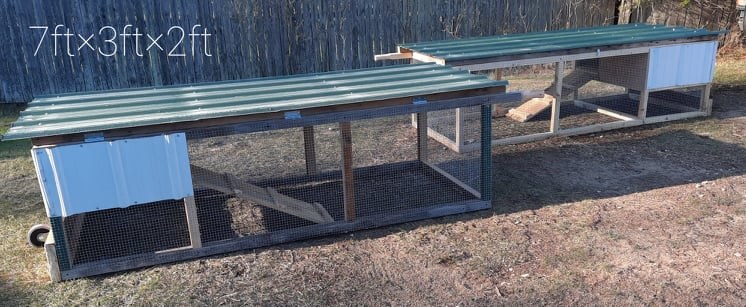
Rabbit Tractor Accessories
Wheels can be attached to the end to move the tractor easily. The rabbit tractors pictured above have one wheel, but I’ve since removed the center wheel because it was too tippy. Now, there’s a 5″ wheel attached to each corner. Two wheels roll better and are less likely to make ruts.
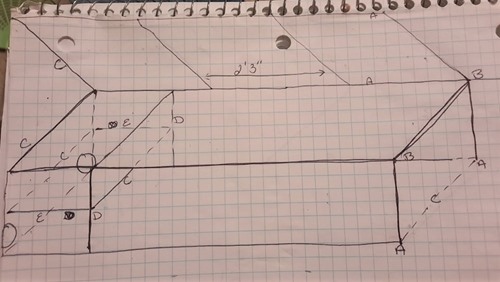
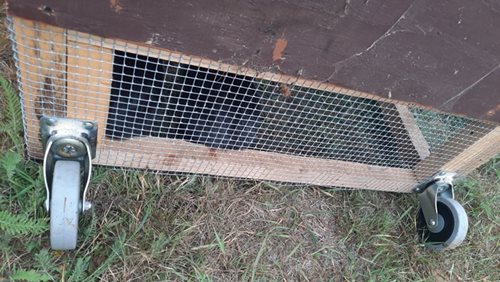
A dual-purpose ramp can be added if desired. The ramp helps rabbits get into the house and can be turned on it’s side to block rabbits from running under the hide. I make ramps for customer’s tractors.
Personally, I don’t use ramps in my rabbit tractors. I want my rabbits to jump into the hide and work those leg muscles! Their food is in the enclosed area as an incentive to hop up and down. When catching rabbits, I’m limber enough to climb in and reach under the hide, so the ramp isn’t needed.
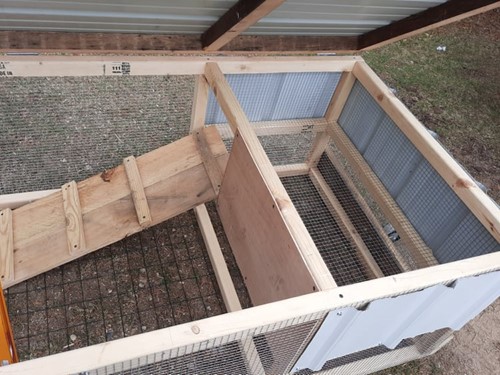
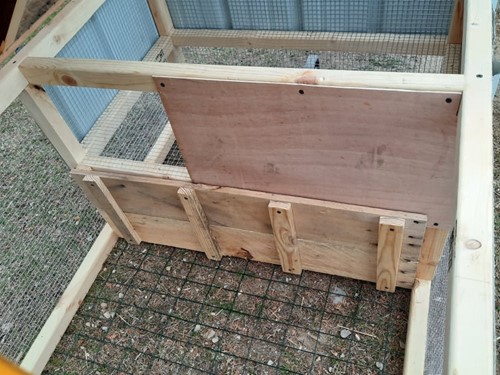
DIY Rabbit Tractor Pros
In my opinion, these rabbit tractors allow the rabbits to have the best life I can give ’em before they are harvested for my family. It’s the least I can do. Here are a few other pros of this design:
- Easy to care for multiple rabbits at one time
- Less grass to mow
- Less poop to clean up out of barn
- Space for rabbits to run and play
- Fresh air and sunshine
- Better muscle tone
DIY Rabbit Tractor Cons
This tractor will protect your rabbits from small predators such as foxes, weasels, and raccoons. However, they are sitting ducks if you deal with large predators. If this is the case, use a sturdy (or electric) fence around your pasture area to keep them at bay.
You’ll need 2 tractors if you separate bucks and does and more if you have multiple litters at once. The number of rabbit tractors needed can really add up. These tractors work best for smaller operations, homesteads, or pet people. A few more cons:
- Need to move tractors daily
- Less ability to regulate temperatures
- Rabbits may be exposed to ear mites/parasites if on the ground
- Not good for wet, muddy conditions
- Rabbits can overheat at high temps
- Can’t use in winter (in areas with snow/ice)
Rabbit Tractor Management
The rabbits in tractors are given fresh food and water every day. Place the food in the hide area so it stays dry. Hang water bottles from the side of the tractor, preferably in on the shady side to minimize algae growth.
Grow-outs go in the tractor at 8 weeks and stay until butcher at 12-16 weeks. Feed grass, weeds, and forage to young kits for a couple weeks before putting them in the tractor to minimize digestive upset. The tractor should be moved to fresh grass once a day to prevent coccidiosis.
These DIY rabbit tractors can fit up to 10 grow-outs. I don’t recommend more than 10, especially if they stay in there til 16 weeks. Boys and girls will need separate tractors if you grow them out to 4 months. Alternately, you can put a litter in one tractor – butcher the bucks at 12 weeks, then grow the does to 16 weeks for more meat and gorgeous pelts.
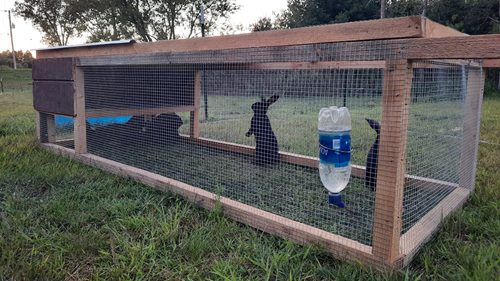
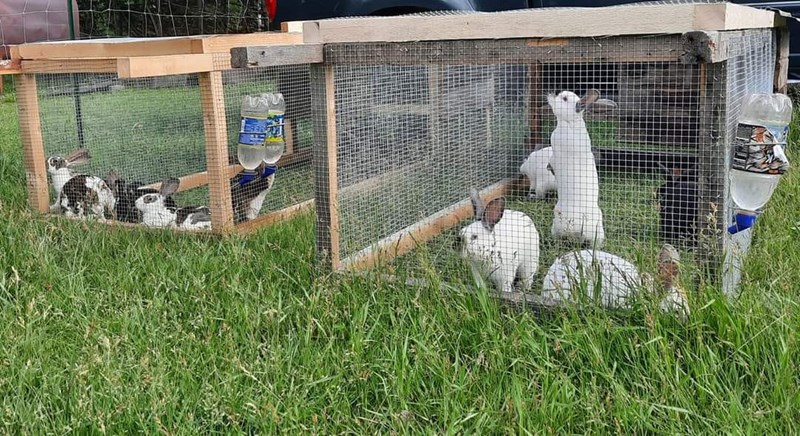
Rabbitry Schedule
My adult does live in a colony… until 1 week before birth. Then they go to the birthing suite. My birthing suite is a 3’x6′ cage. Moms give birth and raise kits there. The kits get weaned at 8 weeks. Moms go back to colony for a 1 month break before being bred and kits go to the tractor. I evaluate the kits to decide if I want to keep any, then post the rest for sale or trade. Boys go in one tractor and girls in another. I double check genders at 10 weeks just to be sure.
I also have a 6′ tractor for my bucks. They get rotated each for one week in there.
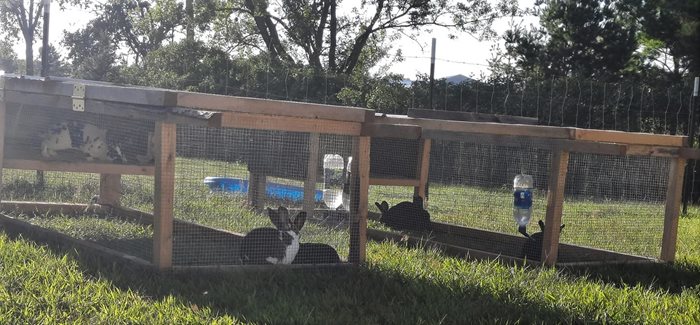
Hope you enjoy my rabbit tractor design!
About the Author:

Amethyst Pines raises Rex, French Lop, and Silver Fox rabbits at Taters Acres Homestead. She has worked with and animals her whole life. Amethyst ran a rescue for bulldogs and exotic animals for 20 years. She has also worked at other rescues, a vet clinic, a kennel boarding & grooming facility, a wild rehabilitation center, and volunteered at a local zoo. Based out of Stephenson, MI, she is currently running her Lil homestead, doing homestead sitting for those who want to go on vacation, and starting a homestead critter transport service.
Related Posts:
- Meat Rabbit Pros & Con
- Breeding Meat Rabbits: From Pairing to Fryers
- Champagne d’Argent: The Color Changing Rabbit
Do you like this DIY Rabbit Tractor Design? Rabbit tractor tips or experiences to share? Please comment below…


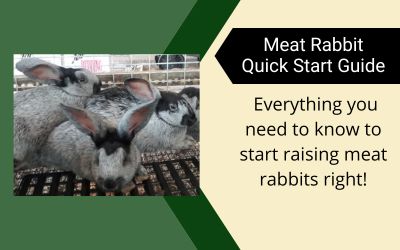
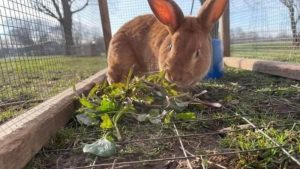


What size lumber? Are all the support beams 2x2s?
Yes. This rabbit tractor can be built out of 2×2’s or ripped 2×4’s. Hope this helps!
I’m looking to raise meat rabbits for the first time and find your guide quite helpful and comprehensive. I am wondering if you can tell me more about their daily lives in cages vs. tractors. If the kits are put in tractors to grow out, do they stay in there overnight or do they all go back to one big hanging cage that’s protected at night? Thanks!
Grow-outs stay in the tractors overnight. I only bring them in for very hot spells, winter, or if prolonged heavy rain is forecast. Hope this helps!
This is very similar to the rabbit tractor I want to make once I get rabbits again. We get snow, ice and cold where I live. I plan on being able to move the tractors inside onto a raised frame during the fall, winter and early spring. I should be able to place one tractor above the other with an extra tin panel at an angle separating them and to help collect the winter manure.
Sound like a great idea! Just be sure that the support frame uses 1/2″x1″ welded wire for the floor, smooth side up (the side with the wires closer together).
What about RHDV2? We were told not to let future rabbits on the ground after one died unexpectedly. The seller said maybe died because of this virus. 🤷🏻♀️
Thanks for mentioning this risk. RHDV2 (Rabbit Hemorrhagic Disease V2) is a deadly virus that kills wild and domestic rabbits. If you live in the southwestern US or other parts of the world where the strain is prevalent (like Australia), please do not put your rabbits on the ground. Familiarize yourself with the disease and take appropriate measures to keep your rabbits safe if you live in these areas. More info: https://www.rhdv2.com/outbreak-maps
Your design looks great, very simple, but sturdy and plenty of room for the rabbits to roam on grass. I was curious if you have a picture of the cages you use as birthing suites. You mention they are 3’x6′- are they the same design as the larger cages or are they set up differently? I’m planning to build several of these tractors next week for our growing bunny operation. Thank you for your help and awesome ideas!
Are there plans with the cut lengths and materials list anywhere? I am a newbie at building and love this hidden shelf as it will protect the grow outs from the rain that we get in OK. Thanks so much!!
Thanks for sharing this. We built something similar last summer.
Thank you for this article!
In Fall/Winter, at what cold temp do I need to move the rabbits from tractors?
Rabbits can handle cold temps as long as they are protected from moisture and wind. Bring rabbits in before the ground starts to get soggy or snow covers the ground, since tractors must be moved daily to prevent coccidiosis. My grow-outs move inside in early October before the drenching fall rains start.
How much are your tractors?
Amethyst makes custom tractors for local customers. She lives in Michigan. Her rabbit tractors cost about $200. If interested, please contact her through her ‘Taters Acres Homestead’ Facebook page: https://www.facebook.com/Taters-Acres-Homestead-109204258127918